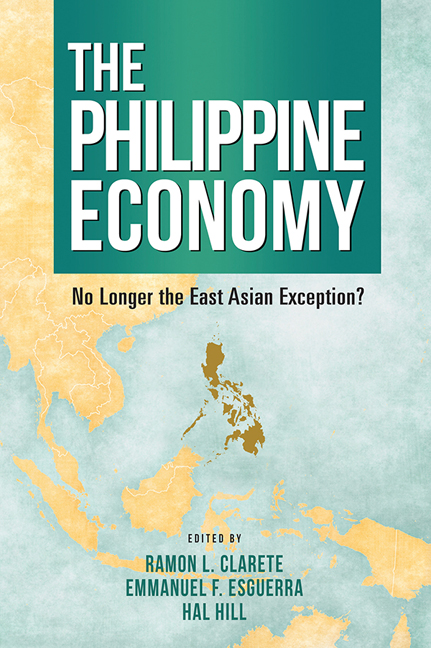Book contents
- Frontmatter
- Contents
- List of Figures
- List of Tables
- Foreword by Arsenio M. Balisacan
- Preface
- About the Contributors
- 1 The Philippine Economy: An Overview
- 2 Economic Growth and Poverty Reduction
- 3 Infrastructure and Urbanization
- 4 Education and Training
- 5 Universal Health Coverage, Health Security and Resilient Health Systems
- 6 Environmental Resources, Shocks and National Well-Being
- 7 Energy: Power Security and Competitiveness
- 8 Development Finance
- 9 Governance and Institutions
- Index
9 - Governance and Institutions
Published online by Cambridge University Press: 12 February 2019
- Frontmatter
- Contents
- List of Figures
- List of Tables
- Foreword by Arsenio M. Balisacan
- Preface
- About the Contributors
- 1 The Philippine Economy: An Overview
- 2 Economic Growth and Poverty Reduction
- 3 Infrastructure and Urbanization
- 4 Education and Training
- 5 Universal Health Coverage, Health Security and Resilient Health Systems
- 6 Environmental Resources, Shocks and National Well-Being
- 7 Energy: Power Security and Competitiveness
- 8 Development Finance
- 9 Governance and Institutions
- Index
Summary
Poor governance and weak public institutions can undermine even the most well-crafted policies to promote inclusive development. Corruption, poor public service delivery, misallocation of resources, political instability, uncoordinated government agencies and deeply embedded patron–client relationships are among the challenges of governance and institutions that slow down or defeat any socio-economic reform agenda. In particular, corruption is a sizable problem in the Philippines, affecting all sectors and levels of government.
In this chapter we refer to governance as the manner in which public officials and institutions acquire and exercise the authority to facilitate collective action, craft public policy and provide public goods and services. On the other hand, institutions refers to the formal and informal rules that shape human interaction and their related enforcement mechanisms. Institutions therefore determine the possibilities for effective governance and collective action (see Figure 9.1). Both the government and market need institutions to function well. Otherwise, government and market failures are likely to litter the landscape instead of properly provided public goods and services. When government and markets work, then collective action outcomes — public goods and services — are more likely to succeed.
It is widely acknowledged in the literature that poor governance and weak institutions are among the critical (Rodrik 2000, 2004, 2007; Nye 2011) constraints to investment and growth in the Philippines (see, for instance, ADB 2007; World Bank 2013; Aldaba 2014). Problems with governance, particularly corruption and political instability, weaken investor confidence and discourage the creation of much-needed jobs that can, in turn, potentially lift many Filipinos out of poverty. Weak institutions constrain the delivery of public goods and services that aim to enhance the supply and demand of labour, both of which are necessary to make economic growth more inclusive. As such, maintaining an environment stocked with adequate and well-functioning institutions is critical.
Poverty amidst weak public goods and services could also debilitate efforts to continue building stronger institutions. As well elaborated in the political science and economic development literature, reformists often struggle against traditional economic and political relationships that are deeply engrained due to a long history of poverty, dependence and patron–client relationships.
- Type
- Chapter
- Information
- The Philippine EconomyNo Longer The East Asian Exception?, pp. 375 - 418Publisher: ISEAS–Yusof Ishak InstitutePrint publication year: 2018

